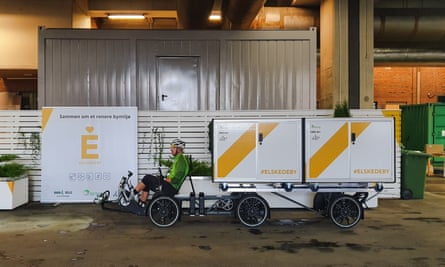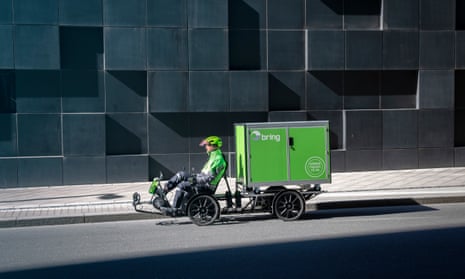The cube truck sidled up to a row of parked cars on a busy Montreal street and threw on its hazard lights, blocking a lane of traffic. The driver hopped out with a package in hand and disappeared into a building, leaving a bottleneck of frustrated drivers in his wake.
“This is exactly what we’re trying to change,” said Agathe Besse-Bergier, a project coordinator with the city, as she watched the scene unfold.
Most delivery trucks worldwide make at least 100 such brief stops a day, causing congestion, air pollution and expensive traffic delays.
It’s a delivery problem known as the “last mile” – the final leg of a package’s journey from distribution warehouse to doorstep – and it has become a bigger problem with the growth of online shopping, particularly same-day and next-day delivery. To meet these short delivery windows, more trucks must be driven into busy city centres, often at the height of rush hour.
“Sometimes those big trucks leave the warehouse full, sometimes half-empty,” said Victor Char, a consultant with Jalon Montréal, an organisation founded by the city to find urban mobility solutions. “Trucks leave the warehouse one, two, three times a day, just to go around and make sure the package is delivered on that date.”
Jalon Montréal thinks it has a solution: Colibri is a pilot system in which hubs are set up in the city to receive packages, which are then distributed using special electric cargo bikes.
The word “Colibri” is a portmanteau of colis and livraison, the French words for “package” and “delivery”, and also the word for hummingbird – an apt moniker, said city councillor Robert Beaudry: the city hopes to create a network of small delivery “nests” throughout the city to replace giant suburban warehouses.

The idea is catching on worldwide. KoMoDo in Berlin, Norway Post’s City Hubs in Oslo and Trondheim, and a scheme in the City of London are just some of these last-mile distribution hubs, which aim to reduce congestion, improve road safety and help cities meet ambitious CO2 emissions targets.
Urban populations are growing, and e-commerce in 2019 is predicted to have expanded by 20% since last year alone. That means more commercial freight – already responsible for a quarter of global CO2 emissions, potentially as high as 40% of cities’ transportation CO2 emissions, and up to 50% of air pollutants.
Nor are the costs only environmental. The European commission has reported that urban traffic congestion costs the EU 1% of its GDP, about €100bn (£86.3bn) a year, because of issues such as food spoilage and lost productivity.
Commercial freight must change, said Glenn Castanheira, an urban retail consultant. “We need to look at [city hubs] the same way we look at public transportation,” he said. “It’s about optimising square footage for maximum efficiency.”
Montreal’s “nest” is located behind an abandoned bus station on the eastern edge of downtown, a decrepit terminal that had been a “scar” upon Montreal since closing in 2011, said Beaudry.
It has now been transformed for Colibri bikes: in the former bus bays sit five shipping containers, each assigned to different partner companies. Inside Purolator’s container sits a 180cm (6ft), 180kg-capacity metal box, full of products, which can be mounted on to the special electric-assist cargo bikes.
Purolator courier Sabino Elliott estimates he makes about 85 deliveries a day on the bikes, about the same number he made in his former delivery truck, but with a fraction of the hassle, emissions and congestion.
He said Montrealers are very curious about the project. “They’re super surprised,” he said, referring to the dozens of times a day he is stopped to answer questions. “I haven’t gotten any negative comments.” His only personal complaint? Montreal’s potholes, which rattle the bike’s aluminium frame. Winter promises to be a struggle, too, with biting temperatures, freezing rain and large snow drifts, although the Colibri team insists it will operate all year round.
Norway, a country that is working hard to build a post-oil economy, also has to weather chilly temperatures and snow, but its national postal service is determined to use hubs throughout the winter as well.

In Oslo city centre it has been using a mix of cargo bikes, electric vans and electric Paxster vehicles instead of parcel trucks for nearly six months, said Fredrik Lindqvist, head of operational development for Norway Post. He said it has led to a 25% increase in worker productivity and a 40% decrease in the service’s CO2 footprint in Oslo.
The biggest time savings, he said, are from having fewer delivery trucks make the 70-minute return trip between downtown and the logistics terminal: instead of one truck per delivery route, only a few trucks need to enter the city, and only to drop off parcels at the hub. Then the e-bike couriers and other small electric vehicles make the last-mile trip.
“Couriers can stock directly where they are supposed to distribute their goods,” he said.
Additionally, Norway Post delivers 80% of consumer packages through its large network of “service points” – kiosks where packages can be dropped for customer pickup – and is also considering night deliveries. These are already in use in New York City, where the Off-Hours Deliveries programme encourages companies to drop packages between 7pm and 6am as a way of curbing congestion and pollution.
Purolator considers the Colibri pilot in Montreal an economic success – last-mile logistics are so complicated that the final leg often accounts for about half the cost of a package’s entire journey – and the company said it would aim to buy up to 20 more e-bikes next year.
Ultimately, however, consumers have a similar role to play in helping cities become less clogged by delivery vehicles, whether electric or otherwise, said Char of Jalon Montréal.
He said online shoppers should avoid unnecessarily rush-ordering packages, thereby giving companies the chance to schedule deliveries at more ecologically sensitive times.
“If you can get it in three days instead of one, and give the opportunity for that package to become consolidated into a truck that won’t be empty, it’s going to be advantageous for everybody,” he said.
Follow Guardian Cities on Twitter, Facebook and Instagram to join the discussion, catch up on our best stories or sign up for our weekly newsletter
